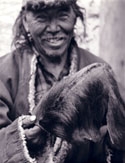Gerald Russell’s Search for the Yeti
Posted by: Loren Coleman on September 25th, 2007

Sometimes all the tumblers in the universe seem to fall into place around one issue. Yesterday, for me, it appeared to in relationship to Gerald Russell and Snowmen skullcaps, the ritual objects made to look like the head of the Yeti.
I was waiting for a Strange Maine visitor to my museum Monday afternoon, following closely the visits of volunteers Jess and Jeff late last week, Lewiston Sun Journal media folks over the weekend, and Salt Institute for Documentary Studies students Monday morning.
I decided to use a break in the visitors to deal with a pile of rare paper items, and began framing some Pangboche skullcap flats from the 1950s-1960s (e.g. an old Edmund Hillary article, a Slick Airways sticker, an archival photo, an old postcard, and the original Tom Slick envelopes that had contained skullcap hair samples from that era).
Moments later, when Michelle from Strange Maine walked in, she had in her hand, as a gift for the museum, an article from a vintage 1959 magazine…with photos from a Japanese expedition of a Pangboche “Snowman scalp.” Unbelievable. I couldn’t have scripted that to happen, especially because of what had also occurred even earlier.
The day had started out with me receiving an email from a Gerald Russell relative, who worked with the reporter who had visited on Sunday. He was seeking information about the man and the Yeti expeditions. Russell, of course, was a leader on the Daily Mail Yeti 1954 expedition, the group that made the first Western discovery of the Abominable Snowman skullcaps. Russell returned during the 1958 Slick-Johnson expedition, to Pangboche and other sites, to investigate them further.
I’ve always been interested in the specific details of Russell’s elusive adventurer biography. I wrote an entry about him in Cryptozoology A to Z and passages on Russell in Tom Slick: True Life Encounters in Cryptozoology. Russell was an old schoolmate of Ivan Sanderson’s, and thus became a friend of Tom Slick’s. Sanderson was a friend of mine, and I’d become the biographer of Tom Slick. Now a relative of Gerald Russell shows up at my email door. (The cryptoworld seemed very small, indeed, yesterday.)
Russell went on several cryptozoological expeditions of note, in 1932 (Cameroons – after various cryptids – with Sanderson), 1933-1934 (Tibet – giant panda), 1936-1937 (Tibet – giant panda – with Ruth Harkness), 1950s (Asia, Europe – making films on capturing animals), 1954 (Nepal – Yeti), and 1958 (Nepal – Yeti).

Norman G. Dyhrenfurth
Later on Monday, when I was looking for something else on the internet – totally unrelated to Yeti – what would I stumble across? None other than the following trailer from a film I’d never seen before – the lost movie taken of the 1958 Slick-Johnson Snowman expedition, filmed by German mountain climber and filmmaker Norman G. Dyhrenfurth, well-hidden on a German site.
Who was pictured among the familiar faces? Gerald Russell. I’d seen motion pictures of the others, but never of Gerald Russell.
I have to share this with you:
Gerald Russell understood animal collection was about being friendly with the locals, getting dirty in your fieldwork, and keeping a low-profile. Ivan T. Sanderson, in 1960, soon after Hillary’s debunking World Book expedition returned, critiqued Hillary’s publicity stunt for being too short, looking in the wrong places (in the snowfields versus the valleys), and having 300 people trek where only a handful of humans should go looking for Yeti.
What were they really looking for in two months, on the higher passes, with 20 times the number of people needed? It doesn’t seem to have been Snowmen.
By contrast, Gerald Russell did it the right way, in 1954 and 1958, often traveling with only one guide. In 1958, Russell was rewarded with seeing a frog-eating teh-lma, along a creek in a montane valley in Nepal.
About Loren Coleman
Loren Coleman is one of the world’s leading cryptozoologists, some say “the” leading living cryptozoologist. Certainly, he is acknowledged as the current living American researcher and writer who has most popularized cryptozoology in the late 20th and early 21st centuries.
Starting his fieldwork and investigations in 1960, after traveling and trekking extensively in pursuit of cryptozoological mysteries, Coleman began writing to share his experiences in 1969. An honorary member of Ivan T. Sanderson’s Society for the Investigation of the Unexplained in the 1970s, Coleman has been bestowed with similar honorary memberships of the North Idaho College Cryptozoology Club in 1983, and in subsequent years, that of the British Columbia Scientific Cryptozoology Club, CryptoSafari International, and other international organizations. He was also a Life Member and Benefactor of the International Society of Cryptozoology (now-defunct).
Loren Coleman’s daily blog, as a member of the Cryptomundo Team, served as an ongoing avenue of communication for the ever-growing body of cryptozoo news from 2005 through 2013. He returned as an infrequent contributor beginning Halloween week of 2015.
Coleman is the founder in 2003, and current director of the International Cryptozoology Museum in Portland, Maine.










hey loren, great new article about the yeti. thanks bill green
You just got me hooked and now I wanna see the rest of it. NOT FAIR!! 🙂
I’m with red! I wanna see more!
I do too. The Yeti (more or less all three groups) and sea serpents were two cryptids that hooked me into cryptozoology back in the day, along with Sasquatch of course.